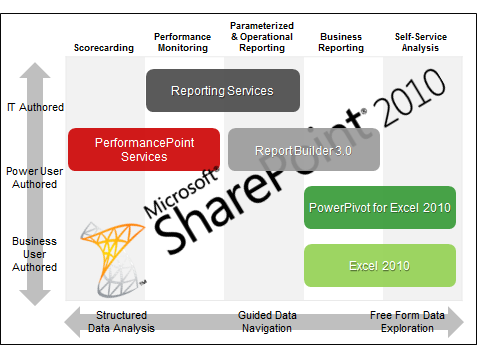Choose the Right Business Intelligence Style for your Project
The Office Business Intelligence group gets the occasional question about why we offer several different BI solutions when our competitors often only offer one. Microsoft offers its customers no shortage of choices when it comes to BI solutions. We do this because, like anything else, there is no single solution for any problem. The hammer isn’t necessarily the tool for every trade, nor every job. And the tool that you can use to break down your business analytics should be no different. In this post, I want to talk briefly about what BI tools Microsoft offers and how they can be used for different purposes.
Choosing which BI application to use is a project-by-project decision. One BI application cannot cover your all your business needs – nor should it be able to. Each BI project has different users, different requirements and different stakeholders. Having choices available when you are planning your BI projects allows you to choose the right style, or tool, for the job.
BI styles depend on how users want to interact with information. The "How to Choose the Right Business Intelligence Technology to Suit Your Style" white paper defines 5 different styles.
- Self-Service Analysis – Self-Service Analysis describes free-form reporting and analysis by users so that they can integrate data from disparate sources and drill-down and understand the root cause for data anomalies. These non-technical users value the ability to perform their own reporting and analysis without relying on IT or others.
Applications: Excel & Excel with PowerPivot - Business Reporting – This style describes formatted reports that are created by advanced business users or analysts. Reports are typically based upon approved corporate data, and then shared more broadly with managers, teams, or departments. In this style, IT involvement is moderate, usually overseeing the distribution and monitoring of the reporting environment and building of the structured data layer upon which the reports are built.
Applications: Excel with PowerPivot or Report Builder - Parameterized & Operational Reporting – Similar to the Business Reporting style, Parameterized &Operational Reporting is also characterized by fixed-format reports. The reports, however, are authored and managed by IT instead of business users and usually follow a pixel perfect format and rendering style. Consistency, scalability, manageability, and automated distribution are some of the key characteristics of this style.
Applications: SQL Reporting Services - Performance Monitoring – This style describes dashboard-style reports that allow users to quickly and easily monitor the performance of their business. This style is catered to executive level or department leadership who require at-a-glance visibility on the health of the business, but it often also permits further investigation via interactivity.
Applications: Excel Services with PowerPivot for Excel, Reporting Services, PerformancePoint Services - Scorecarding – Scorecarding is a style that describes highly summarized views with Key Performance Indicators (or KPIs) measured and scored against predefined targets such as a balanced scorecard. This style is generally a part of a performance management program, though it can also be used to measure operational performance.
Applications: Excel Services with PowerPivot for Excel, Reporting Services, PerformancePoint Services
The BI style can be compared to the type of author and how structured the data is. The chart below shows how the different Microsoft BI tools fit in this matrix.
Microsoft provides a variety of BI applications that fit a variety of situations. You can see that choosing just one application for all your BI needs would limit the type of BI projects you can accomplish. Having a choice allows success on all your BI projects.
Joe Wallace
Senior Program Manager Lead
Office BI
Comments
Anonymous
November 17, 2011
Great post Joe. Where would you say Power View fits into all this?Anonymous
November 17, 2011
James, it falls somewhere between self-service and business reporting, leaning more toward self-service.Anonymous
November 22, 2011
your work is good and it is full of knowledge thanks <a href="www.mlfhardwoodflooringltd.ca ">hardwood flooring toronto</a> for the share.Anonymous
November 29, 2011
We are in the process of building a solution using Microsoft BI. The cube foundation is great. The various reporting tools are not. The current state is the result of various acquisitions and no long term consolidated approach. Marketing (or Program Management) often take this common state of affairs and spin it. Joe is doing the same here. "We offer choices", "one size doesn't fit all". Hah. Have a look at Cognos or Microstrategy. They put in the work of consolidating various tools into a single cohesive suite. Having things work together doesn't mean you have to have separate products. Take Excel for example. It is the same product used by M&A Finance pros at Goldman Sachs and my mom for tracking Christmas card lists. Wheres your hammer and nail now?... Marketing fluff. Fragmentation is inevitable for a long-standing company that acquires software. Still Microsoft needs a consolidated BI strategy that understands all the roles and all the uses and puts them together in a single platform.Anonymous
December 19, 2011
The comment has been removedAnonymous
February 08, 2012
Hi Joe, Is it capable to have complex reports in PPS? My scenario is i have data in my cube for Jan, Feb, April and May. I don't have transactional data for March. But my requirement is to display the last available month data for few fields with few values should be 0 since it is not available. Generally this can be handled in reporting tools. Is this possible in PPS?. It would be great, if you can help me out on this.Anonymous
May 29, 2012
Hi Joe forget about complicated reports in PPS, it is very unflexible, you cannot get many results at all. Seems that PPS has been abandoned and MS is not going to correct current PPS bugs (not mentioning new versions and functionality). Pitty...
